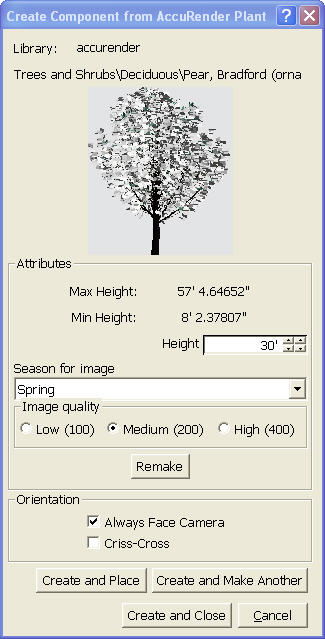IRender nXt Plants

SketchUp model with 2 AR3 Library Plants
There are three ways to place Plants in IRender nXt:
- Download Plant Components from the 3D Warehouse
- Create a new plant with the Tree Editor
- Load a nXt plant from the nXt Plant Library.
- Load an AR3 plant from the AR3 Plant Library.
Contents
3D Warehouse Trees
A number of plants are being placed in the 3D Warehouse. These plants can be placed directly into your SketchUp model, and will render as Fractal nXt plants.
Here is the collection of premade plants.
Tree Editor
Trees are placed in SketchUp as 2D side (and optionally 2D top) images and then rendered as full 3D Fractal trees.

- See: Tree Editor for information on creating and editing trees.
nXt Plant Library

The Plant Libraries contain various pre-made RpTreeMaker plants
These libraries are stored in the nXt_Materials folder in your Libraries folder.
To access these libraries:
- Select Create Plant from the IRender nXt Toolbar:
- Select Load from Library... to open the library of nXt Plants.
- Turn on thumbnails if you want to see samples of each material as you load it.
AR3 Plant Library

- Select the Create Plant icon form the
IRender Plus
toolbar:
- Select a plant from the nXtRender libraries.

Set the height and other parameters and place the plant.
Seasons

Mapping a Fractal Plant to a SketchUp Plant - Early Spring
AR3 Plants can automatically change appearance to match the seasons.
This makes it easy to make client presentations to show what a building site, or landscaping project will look like in varying seasons.
Plant changes for various seasons:

Late Spring

Summer

Winter
Plant Size
Plant sizes are determined by the trunk size, so the plant can be sized to match the height or width of a component, but not both.
When mapping a fractal plant to a component, you can specify whether the fractal plant will match the height or width of the component.
Rendering Plants
You can Render Plants as 2D images, or full 3D, Fractal plants.
The 3D Fractal Plants show more and more detail, the more you zoom in on them.
But for plants which are in the background, the 2D images work well and save considerable rendering time.
Here is a rendering of two plants - zoomed in - the one on the left is rendered as a 2D image, the one on the right is rendered as a 3D, Fractal plant. If you look closely you can see the better detail in the 3D, Fractal plant.

However, when these two plants a zoomed out a bit the difference is almost not noticeably.
Notice that shadows work quite well for the 2D image plants as well.

2D Image Resolution
When you create the plant, you specify the resolution to be used the 2D image of the plant in SketchUp and for the plant is it is rendered as a 2D image. It is worth creating the plant with a higher resolution if you are going to render it as a 2D mage.

Rendering Plants as 2D images
You can either render all plants as 2D images, or you can render some in 2D and some in 3D by right clicking on the individual plants you want to change.
The All Plant setting is on the Render 2 Tab and there are also buttons to mark all plant instances to Render in 2D or 3D. You can flag all instances 2D, for example, and then just select a few plants to render in full 3D.


